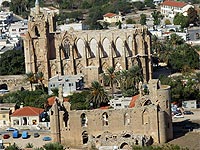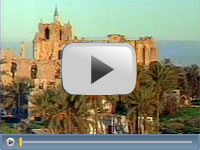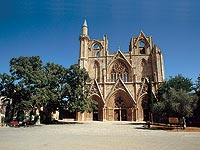
Lala Mustafa Pasa Mosque in Famagusta, North Cyprus.
 |
the north cyprus travel guide |
 |
|
Lala Mustafa Pasa Mosque
|
 Lala Mustafa Pasa Mosque From Air photo by: TAK News Agency [ enlarge photo ] |
Right at the heart of the old walled city of Famagusta, North Cyprus, lies the Lala Mustafa Pasa Mosque, the former St Nicolas Cathedral. From the 14th century, this imposing building has dominated the square at the heart of the old walled city of Famagusta, Its twin towers can be seen from all over the city, one tower topped with a minaret on one side. Both spires suffered during the Turkish bombardment in the siege of 1571, and from subsequent earthquakes, but they still stand proud on the city skyline today.
The Western façade of St Nicolas Cathedral
The western facade faces the square, and if it looks vaguely familiar, it's because the whole building was based on one of Europe’s greatest Gothic cathedrals, Rheims Cathedral in France. Famagusta was so wealthy and so influential at this time, that the city masters decided it needed a full-blown Latin cathdral. So it's also not surprising that the architects were brought from France to design this Gothic masterpiece. St Nicolas Cathedral in Famagusta was built between 1298 and 1326, and with its three pointed gables elegantly pointing towards the rose window above, it makes a fine sight from a shady table at one of the square's two cafés! Since St Nicolas Cathedral was built in the same brown limestone as the surrounding city walls of Famagusta, it also seems to fit exactly into its surroundings. The only stained glass to survive the bombardment in the siege of 1571 is the six-part rose window, high up on the front of St Nicolas Cathedral.
 St Nicholas Cathedral Video video by: TRNC Ministry of Tourism [ play video ] |
The oldest living tree in Northern Cyprus?
To the left of the facade is a small Ottoman tomb dating from 1700, and a small shrine. The old tree in front of the main door is said to have been planted in 1250, and is an East African fig tree. It is said to be the oldest living tree in Cyprus, and certainly over the years it has sprouted many trunks that support the original tree. The old Venetian loggia, which faces the tree, is now used for mosque ritual ablutions. Under one of its round windows, you can see a frieze with wild animals running through foliage, originally taken from a temple building at Salamis. On both sides of the mosque, the massive buttresses that support the roof stand in stately splendor, providing a nice, cool shady spot in the midday sun!
Inside the Lala Mustafa Pasa Mosque
There is an entry charge to St Nicolas for foreign visitors, but at under £1, it's a price well worth paying to see this wonderful building. Since this is also a mosque, due modesty in dress and respect is required, so legs must be covered (no shorts), and headscarves should be worn by women. The curator will supply covering garments if you do not come suitably attired. The floor is covered with a carpet, and you will be shown around by an Imam. (You will also have to remove your shoes at the door.)
Once inside, the nave rises above you, its whitewashed walls seemingly enhancing the sense of space and light. (The whitewash and plaster covers any representation of the human form, not permitted in mosques.) The vaulted roof is supported by two series of six columns, that seem to effortlessly support the magnificent roof above. Here, the Lusignan kings would come to be crowned King of Jerusalem, once they had been crowned in Nicosia. They would wave from the balcony above the main west door once the crown was safely on their head! Today, this vast space is occupied by the humble fixtures of a mosque, from the wooden pulpit to the niche indicating the direction of Mecca.
 Lala Mustafa Pasa Mosque photo by: Anonymous [ enlarge photo ] |
Lala Mustafa Pasa, the conqueror of Famagusta
The mosque was named after the Turkish leader who laid siege to the city in 1571, and who converted the church into a mosque in 1571. Famed for his bad temper, Lala Mustafa Pasa promised safe passage to the Venetian commander Marcantonio Bragadino after the city of Famagusta had surrendered. However, once Lala Mustafa had seen how so few men hand thwarted his mighty Turkish army, he changed his terms of surrender, and demanded a hostage against the safe return of the Turkish fleet. When Bragadino protested, Lala Mustafa retaliated by accusing the Venetian of murdering some civilian prisoners in the last days of the siege. The hapless Bragadino was imprisoned, flogged on two pillars that still stand outside the Cathedral, then killed. Such was Lala Mustafa's anger that Bragadino's skin was then stuffed with straw and dragged around the town by a cow.
It seems that St Nicolas was associated with anger from its first days of construction too. Legend tells how the master architect of St Nicolas was jealous of the talent of his apprentice, and lured his young student up to the top of the towers to point out a 'design fault'. When the student tried to see the fault, his master pushed him off the tower to his death. Today you can contemplate such as fall from the comfort of the small cafe (summer only) that occupies a former chapel at the rear of the mosque.
| PARTNERS |





 Advertise on this site
Advertise on this site
|
North Cyprus quick: holidays | flights | hotels | property | kyrenia | famagusta | photos | map | weather | history | news
All text is copyrighted by Cyprus44. Photographs are copyrighted by their respective photographers.
For more information read our copyright policy, privacy policy and disclaimer.
This web page is served on 18 September 2025 at 6:44:11 PM.
![]()
Cyprus44 in other languages: Nordzypern | Chypre Nord | Severní Kypr | Северный Кипр
partner sites: goNorthCyprus Travel | Pacific Rent-A-Car | Amy Holiday Villas | other partner sites

